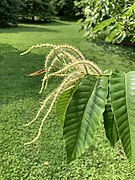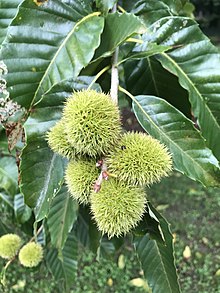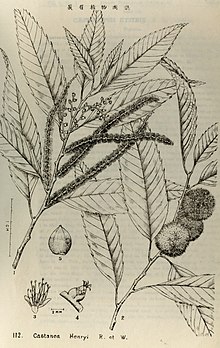-
 Flowers
Flowers -
 Nuts
Nuts

KNOWPIA
WELCOME TO KNOWPIA
Summary
Castanea henryi, Henry chestnut, Henry's chestnut, or Chinese chinquapin (a name it shares with Castanea seguinii), pearl chestnut, and in Chinese: 锥栗, zhui li, is a species of chestnut native to south-central and southeast China.[2] A tree reaching 30 m, it is a source of good timber, but has smaller nuts than its size might suggest. Like its close relative Castanea mollissima (Chinese chestnut) it is widely cultivated in China, and quite a few varieties have been developed in recent times.[3]
| Castanea henryi | |
|---|---|

| |
| In fruit | |

| |
| Castanea henryi botanical illustration | |
| Scientific classification | |
| Kingdom: | Plantae |
| Clade: | Tracheophytes |
| Clade: | Angiosperms |
| Clade: | Eudicots |
| Clade: | Rosids |
| Order: | Fagales |
| Family: | Fagaceae |
| Subfamily: | Quercoideae |
| Genus: | Castanea |
| Species: | C. henryi
|
| Binomial name | |
| Castanea henryi | |
| Synonyms[2] | |
| |
References edit
Wikimedia Commons has media related to Castanea henryi.
- ^ C.S.Sargent, Pl. Wilson. 3: 196 (1916)
- ^ a b "Castanea henryi (Skan) Rehder & E.H.Wilson". Plants of the World Online. Board of Trustees of the Royal Botanic Gardens, Kew. 2017. Retrieved 28 August 2020.
- ^ Li, Ying-Lin; Gu, Guang-Shi; Wu, Jun-Jian; Liu, Bin; Ye, Shu-Tao; Chen, Hui; Chen, Shi-Pin; Li, Yu (2020). "The complete chloroplast genome sequence of a Castanea henryi cultivar". Mitochondrial DNA Part B. 5 (1): 180–181. doi:10.1080/23802359.2019.1698376. PMC 7748877. PMID 33366476. S2CID 212796769.




